Verdict
As Beyerdynamic’s first attempt in the true wireless market, the Free BYRD can’t quite overcome a feeling that they err on the safe side. There’s plenty that they get right, and not much they get wrong, and the result is an enjoyable pair of true wireless buds to use and listen, but which don’t stand out much from the rest of the pack. Here’s hoping that Beyerdynamic builds on this solid foundation for whenever the sequel appears.
Pros
- Assertive bass, energetic performance
- Good comfort
- Excellent Bluetooth connection
- Mimi sound personalisation
Cons
- Good but not great ANC
- Not as precise or clear as rival true wireless
- Build quality doesn’t feel premium
Availability
- UKTBC
- USARRP: $249
- EuropeTBC
- CanadaTBC
- AustraliaTBC
-
MIY appCustomise sound and noise cancellation with app -
Mimi sound personalisationCreates sound profile to adapt music to hearing ability
Introduction
Free BYRD sounds as if it could be song from the 1970s, but this moniker serves as Beyerdynamic’s entry into the true wireless market.
This is another brand in an increasingly long list of esteemed headphone makers such as Astell & Kern, Bowers & Wilkins and Final trying to capitalise on the growing true wireless market far later than their rivals.
The Free BYRD nestle at the premium price point, which means they’re up against the likes of Bose, Sennheiser and Sony in capturing the hearts of audio fans on the search for great performance. The German marque is playing a game of catch-up given that both Sony and Sennheiser are on their third premium attempt. So how does Beyerdynamic fare with its first attempt?
Design
- Not particularly premium-looking
- Good range of ear-tips provided
- Comfortable to wear
- Easy enough to operate
I find there’s something a tad generic about the Free BYRD’s appearance. Aside from the black ribbon strip on this grey sample (there’s also a black version available), the BYRD take on the characteristics of many a true wireless set of buds that have come before.
The corkscrew design is a bit chunky, but it does help the buds to slot into the ear and create a noise-isolating seal to protect against external noises. The plastic nature of the finish doesn’t necessarily convey the premium price point that the BYRD buds are hitting, but it does help keep them relatively light at 7g per earphone.
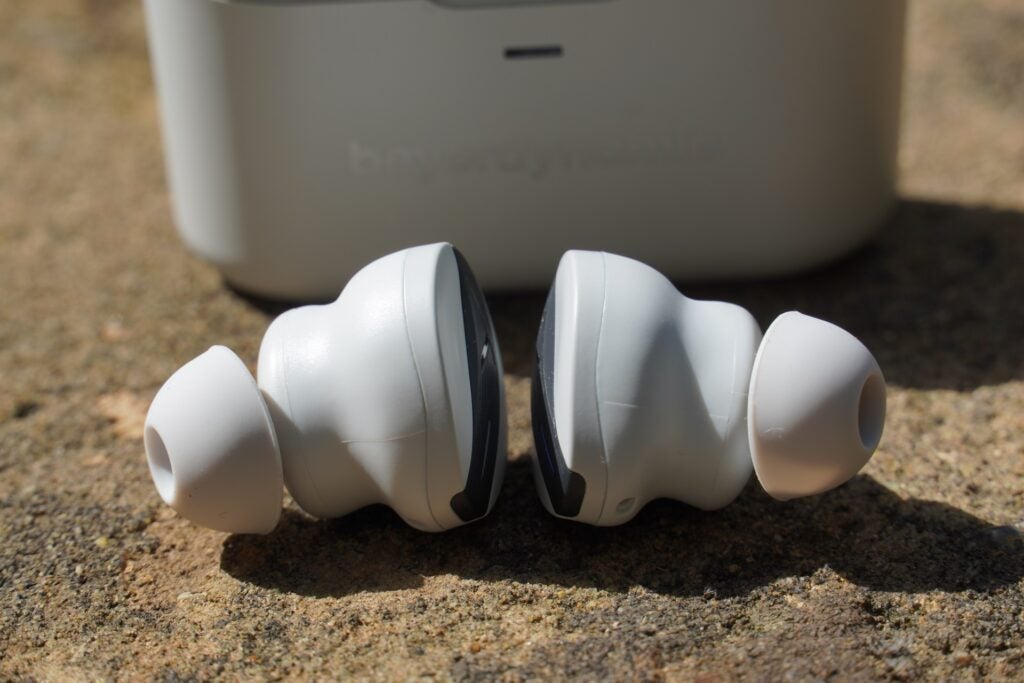
Comfort levels have been good, the smooth finish of the earbuds presented no chafing, irritation or any of that oily feel that you can sometimes get with cheaper true wireless or on older designs.
The fit isn’t the most snug, even after you’ve twisted to lock the buds in; but they give no indication they’d fall out. Unlike some other premium earphones (such as the Fidelio T1), then, you won’t have to constantly fiddle with them to ensure they stay put. There’s a wide selection of ear-tips supplied with the earphones, from five silicon ear-tip sizes (XS to XL) and three foam ear-tips (S to L), which Beyerdynamic says are suited for sports use.
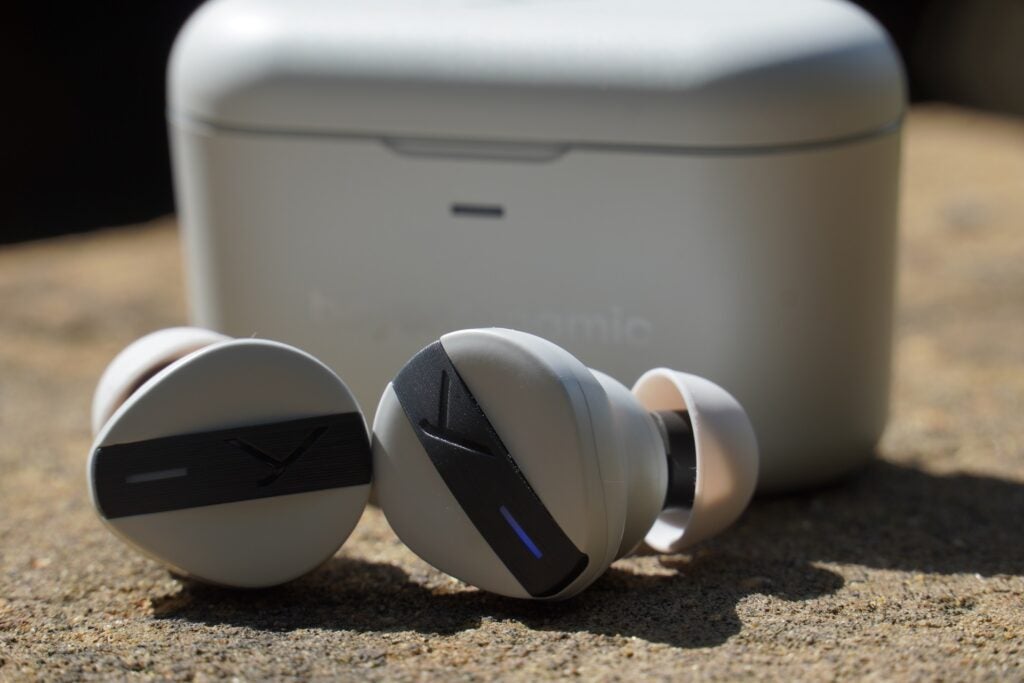
Operating the earphones has proved stress-free, with the tactile feel of the ribbon strip serving as a clue about where to press.
The BYRD respond to taps: one for playback; two for ANC/transparency; three for skipping to the next track (right earbud) or skipping back (left earbud). A tap and a hold activates the voice assistant, while two taps and a hold (on the second tap) controls volume levels. This offers convenience in that you won’t need to fish out your smartphone or personal music player much at all.
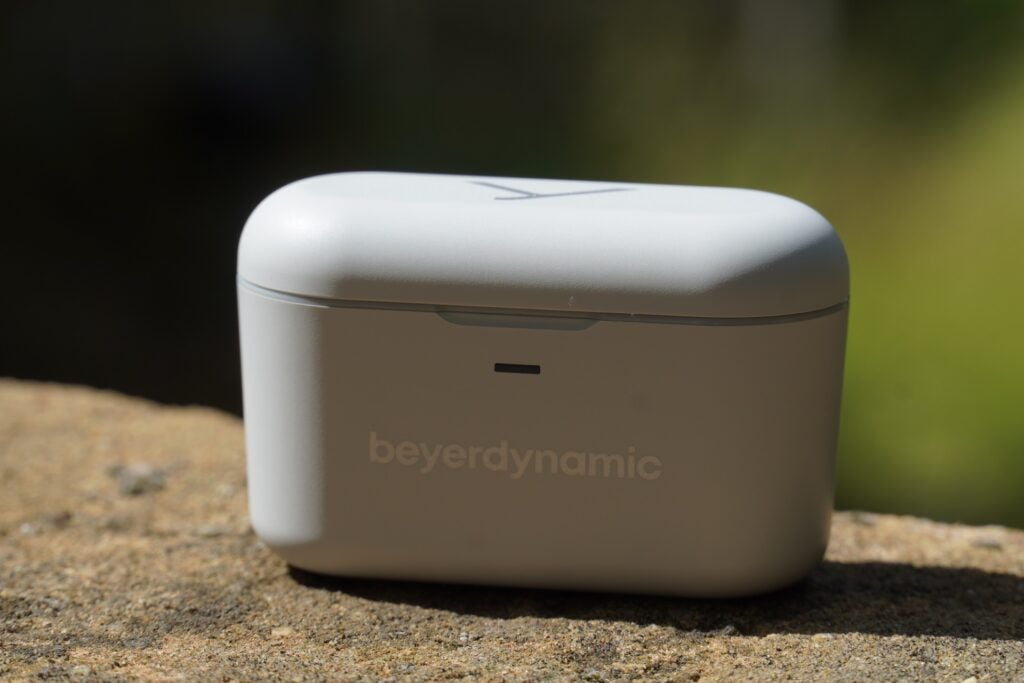
The finish of the charging case matches the wireless earphones themselves, in-keeping with the solid if not eye-catching aesthetic developed. It’s a compact unit, similar in size to the WF-1000XM4’s case, and features a USB-C port for charging and an LED indicator on the front.
Features
- Good noise cancellation
- Excellent wireless signal
- MIY app offers some customisation/personalisation
Like virtually every premium set of wireless earphones, the Beyerdynamic carry active noise cancellation and transparency modes. The ANC isn’t of the adaptive variety featured on some other premium earphones, so it’s a one-size-fits-all solution. The same is true of the Transparency mode, whose level you can’t change.
Having used the Free BYRD for just over a week, I think the hybrid noise cancellation is good but not great. It targets bassy sounds and zaps ambient noises dutifully; voices are diminished; vehicles are reduced to the rattle of their engines; and the whooshing sound of buses as they go past is toned down.
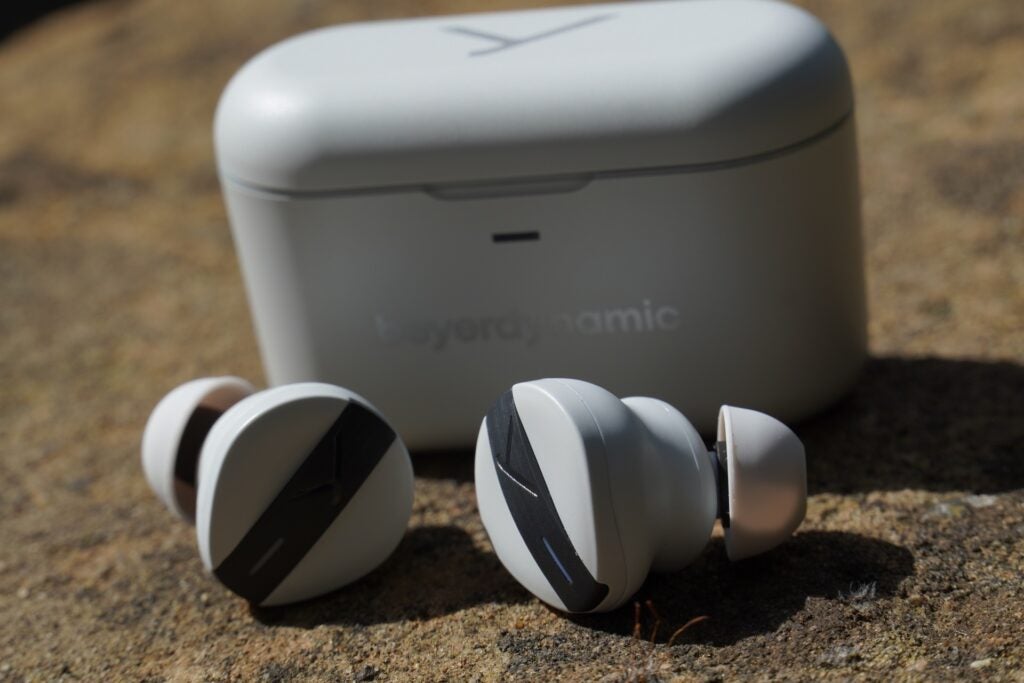
But there are still noises that evade the Beyerdynamic’s noise cancellation: the clanking sound of an escalator to sounds from further away, such as a train on another platform. It isn’t as comprehensive as the Bose QuietComfort Earbuds, and even compared to the LinkBuds S – Sony’s true wireless buds feature better suppression thanks to their combination of tight fit and ANC.
The Transparency mode lacks outright clarity and detail compared to other premium options – but it’s perfectly fine, I should add, aptly bumping up awareness of surroundings. However, at this price point you could get slightly clearer, more insightful ambient modes such as those on Astell & Kern’s UW100.
Bluetooth support is v5.2 and codec streaming goes up to aptX Adaptive, which ensures the earphones stay tethered to your source device, even in busy areas. So far, the wireless performance has been fantastic, with not even the slightest hint of the signal dropping or any fluctuations at busy train stations or in crowded places.
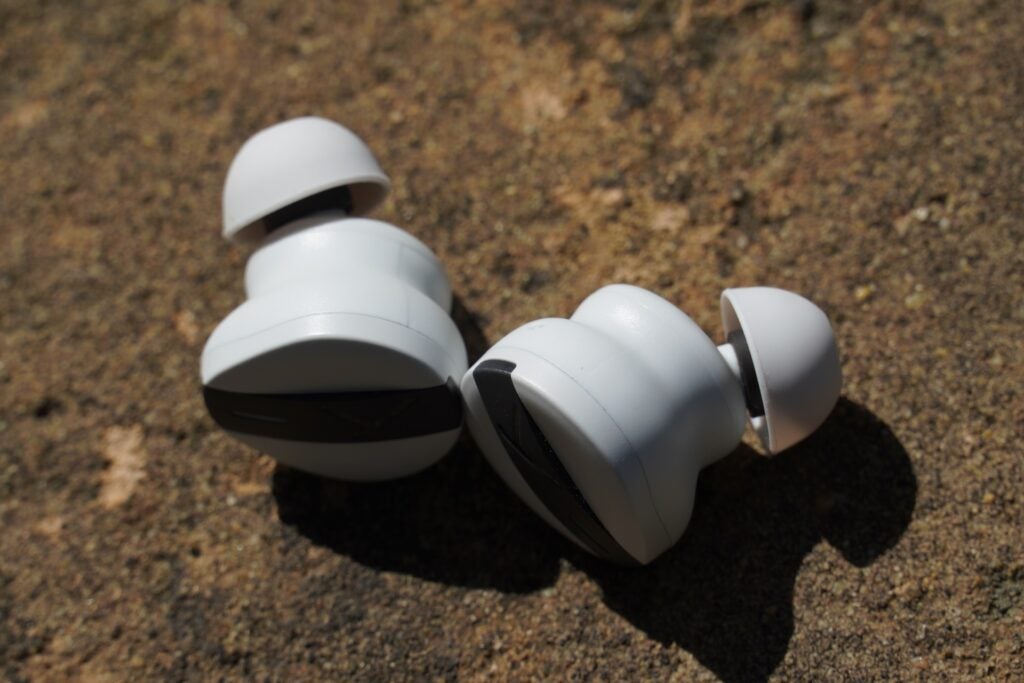
Other features include Google Fast Pair with Android devices, so you won’t have to head to the Bluetooth settings for the initial pair. Amazon Alexa is built-in for hands-free voice assistance; other digital butlers are available via the controls. I haven’t been able to test the call quality as yet, but the Free BYRD feature a two-mic setup and Qualcomm’s cVc tech for voice clarity.
Launching alongside the earbuds is Beyerdynamic’s MIY (Make It Yours) app, which offers customisation of the various noise-cancelling modes, low-latency modes for gaming and firmware updates.
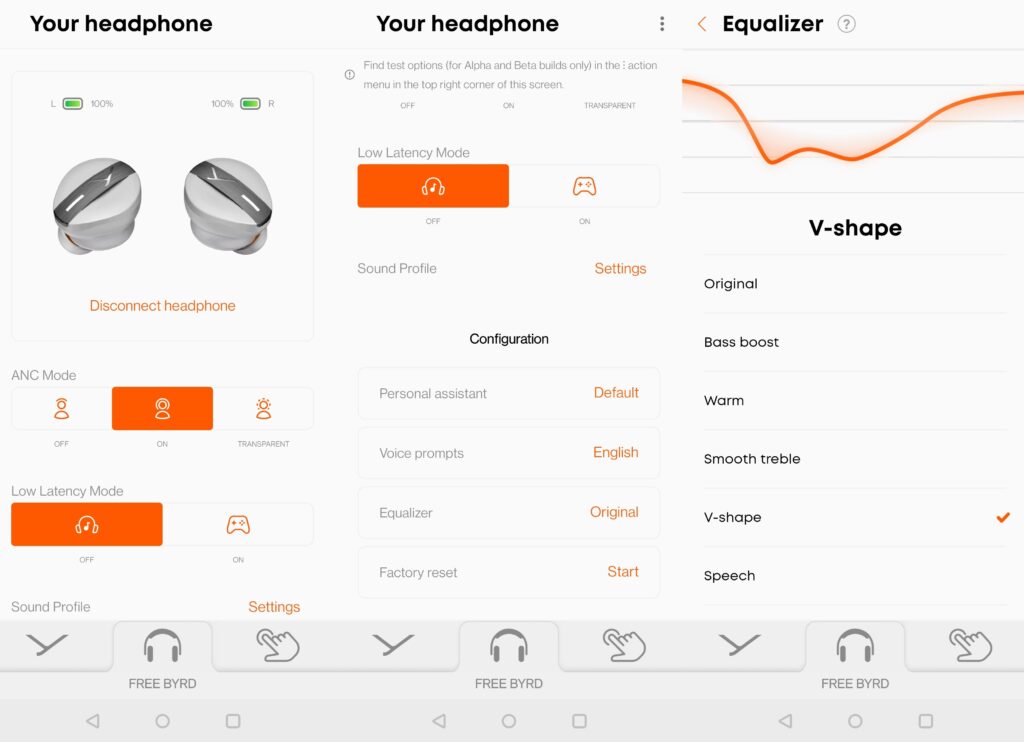
It also offers data on your use, such as how long you’ve been listening to them and how long you’ve spent calling people, which is interesting.
You can’t customise the touch controls, which feels like a slightly odd omission; but, then again, practically everything is covered by the earbuds’ controls. There’s wear detection, too – another feature that’s solidly implemented, but it can’t be adjusted/turned off in the app.
Sound personalisation is available via Mimi, which has featured in some Cleer and Kygo true wireless efforts. It measures your hearing through a series of ascending and descending bleeps against white noise to determine how well you hear, and then adapts the stereo sound to your hearing ability by compensating for certain details. Apparently, the higher the pitch, the less I hear, so much of the rebuilding is done at the higher end of the frequency range. I certainly detect a sharper tone listening to music when switching between the two.
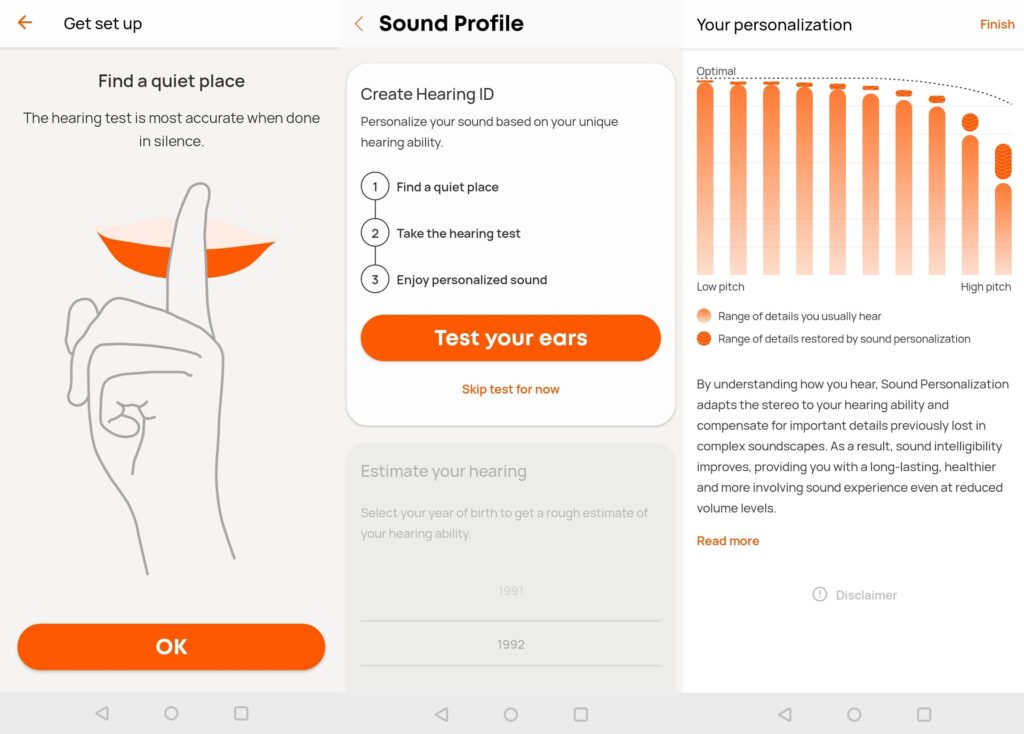
You can customise the sound further via the equalizer setting that offers Bass Boost, Warm, Smooth Treble, Original, V-shape, Speech and Brilliance. Playing around with a few of them, V-shape expanded the dynamic range of audio, but does come at the cost of a recessed mid-range.
An hour of use brought battery life down to 85%, drainage that was in the ballpark over multiple tries. The Free BYRD claim 11 hours of battery life without ANC and Beyerdynamic claims roughly around 8 hours with noise cancellation. If battery drainage remains consistent, it would suggest about 7 hours with ANC on, which falls short of its target. Fast-charging delivers 70 minutes from a 10-minute charge, and there’s wireless charging support too.
Sound Quality
- Impactful bass
- Big, energetic soundstage
- Not as precise or detailed as close rivals
In the end, every set of earphones will ultimately be judged on their sound quality, and as is the case with the Free BYRD’s design and features, the Beyerdynamic’s performance falls short of the class leaders.
There’s a consistency to the way the Free BYRD go about their business, but there’s also a lack of flavour to their performance too. They’re a solid, entertaining pair, but at this price “solid” doesn’t see you stand out from the pack.
Listening to the buds in the Original preset and they are flat with good balance across the frequency range, solid (there’s that word again) detail and clarity, and reasonable levels of insight into a stereo recording.
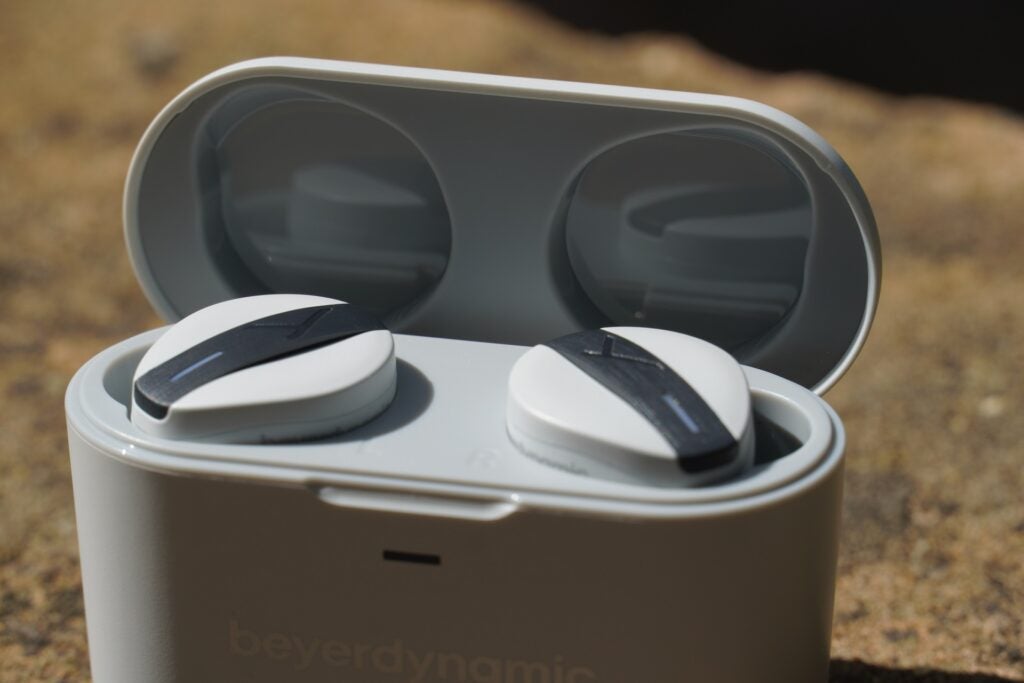
The soundstage is big and wide from their 10mm drivers, and the instruments and voices are also big in description, lacking that finer feel of detail and separation between the various elements. The sonic stereo image the Free BYRD paint is quite broad in size – listening to Hesham’s Nazih’s Moon Knight and comparing to the Sony WF-1000XM4, the Free BYRD lack the precision, definition and naturalism those earphones offer in the way they describe the orchestra and chorus.
But there is bundles of energy married to a good tonal balance across the frequency range, with crisp highs, weighty and assertive bass, and a clear enough mid-range. The Beyerdynamic claim to be able to reach 10Hz on the low-end, and that certainly gives bass notes more impact in Beyoncé’s Déjà Vu and Busta Rhymes’ Touch It. They’re a bit tougher and aggressive in their approach than the Bose QuietComfort Earbuds.
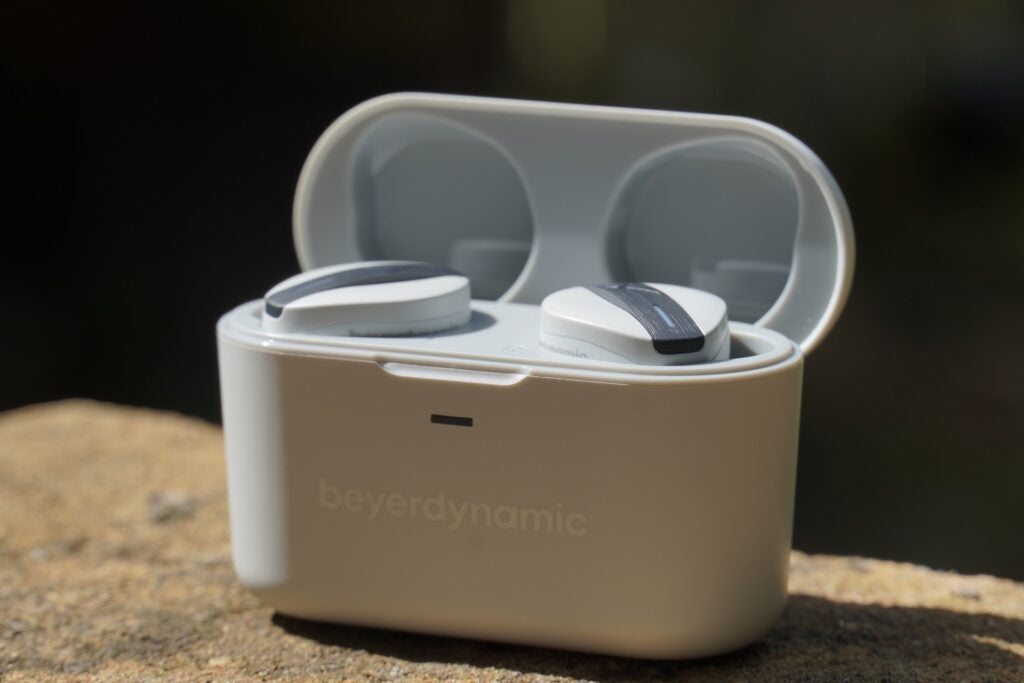
Vocal handling is decent, but not displaying the same clarity or fidelity that the Sennheiser Momentum TW 3 bring to proceedings. However, they’re separated enough that, say, the guitar in Wheatus’ Teenage Dirtbag doesn’t affect vocal intelligibility. Listening to Fake Passport from the Moon Knight soundtrack, I actually prefer the brighter, richer tone that the LinkBuds S produce with the violin playing in the track. The LinkBuds S have more character to their sound, something the Free BYRD lack.
Dynamically, the Free BYRD can sound less expressive and less precise when playing Corinne Bailey Rae’s Put Your Records On than Sony and Sennheiser buds, whether it’s dealing with the smaller-scale harmonics or the broader flows of the track. Switching to the V-shape preset did bring more flourish and emphasis to this aspect of their performance.
All told, the Free BYRD are an engaging listen, and their tonality works with a range of music genres; but they don’t quiet stand out.
Latest deals
Should you buy it?
If you hate connection drops There’s yet to be a stutter or even a flutter with these earphones, with the aptX Adaptive Bluetooth connection proving super-reliable.
You want more fidelity The Beyerdynamic produce a big, broad sound; but compared to the likes of the Sony and Sennheiser, their tuning lacks the finer details and precision that those earphones offer.
Final Thoughts
The Free BYRD put in an engaging, steady performance, but they lack the overall fidelity of rival wireless earphones. On the sound front, there’s a little flavour missing in their tone, alongside those last few bits of detail, clarity and sharpness that would put these earphones in the company of Sony, Sennheiser and Bose.
The ANC and Transparency modes also fall short of the class leaders; but the performance is admirable, nevertheless. Otherwise, there’s a lot that the Free BYRD get right, from comfort to their Bluetooth performance. In addition, the introduction of Mimi sound personalisation is a nice bonus for personalising the sound to your hearing ability.
Ultimately, there’s a feeling that the Free BYRD have taken the safe route, looking to nail down the basics first time round. These aren’t earphones that bring new ideas to the table, or reach as high a level of performance as the brands mentioned above. Nevertheless, they’re an enjoyable-sounding pair of buds. Let’s hope the Free BYRD 2 build upon this solid base.
How we test
We test every headphones we review thoroughly over an extended period of time. We use industry standard tests to compare features properly. We’ll always tell you what we find. We never, ever, accept money to review a product.
Find out more about how we test in our ethics policy.
Tested for more than a week
Tested with real world use
FAQs
The Free BYRD support Barge-In Dynamic Connect, which allows for seamlessly switching between any paired device (up to six) without powering off Free BYRD or the source device.
Sustainability
TrustedReviews’ holds the fact that global warming is not a myth as a core value and will continuously endeavor to help protect our planet from harm in its business practices.
As part of this mission, whenever we review a product we send the company a series of questions to help us gauge and make transparent the impact the device has on the environment.
We currently haven’t received answers to the questions on this product, but will update this page the moment we do. You can see a detailed breakdown of the questions we ask and why in our sustainability info page.
Jargon buster
Bluetooth
Bluetooth – named after 10th-century Danish king Harald Bluetooth who united Denmark’s tribes into a single kingdom – is a method of wireless transmission that allows for the exchange of data between devices over short distances.
ANC
ANC (Active Noise Cancellation) uses an array of microphones in a headphone to detect the frequency of the sound coming at the listener, with the ANC chip creating an inverse wave (i.e. opposing sound) to suppress any unwanted external noises.
Google Fast Pair
Google’s Fast Pair is a proprietary technology that uses Bluetooth Low Energy to quickly pair devices in close proximity to each other when they’re first used
Verdict
As Beyerdynamic’s first attempt in the true wireless market, the Free BYRD can’t quite overcome a feeling that they err on the safe side. There’s plenty that they get right, and not much they get wrong, and the result is an enjoyable pair of true wireless buds to use and listen, but which don’t stand out much from the rest of the pack. Here’s hoping that Beyerdynamic builds on this solid foundation for whenever the sequel appears.
Pros
- Assertive bass, energetic performance
- Good comfort
- Excellent Bluetooth connection
- Mimi sound personalisation
Cons
- Good but not great ANC
- Not as precise or clear as rival true wireless
- Build quality doesn’t feel premium
Availability
- UKTBC
- USARRP: $249
- EuropeTBC
- CanadaTBC
- AustraliaTBC
-
MIY appCustomise sound and noise cancellation with app -
Mimi sound personalisationCreates sound profile to adapt music to hearing ability
Introduction
Free BYRD sounds as if it could be song from the 1970s, but this moniker serves as Beyerdynamic’s entry into the true wireless market.
This is another brand in an increasingly long list of esteemed headphone makers such as Astell & Kern, Bowers & Wilkins and Final trying to capitalise on the growing true wireless market far later than their rivals.
The Free BYRD nestle at the premium price point, which means they’re up against the likes of Bose, Sennheiser and Sony in capturing the hearts of audio fans on the search for great performance. The German marque is playing a game of catch-up given that both Sony and Sennheiser are on their third premium attempt. So how does Beyerdynamic fare with its first attempt?
Design
- Not particularly premium-looking
- Good range of ear-tips provided
- Comfortable to wear
- Easy enough to operate
I find there’s something a tad generic about the Free BYRD’s appearance. Aside from the black ribbon strip on this grey sample (there’s also a black version available), the BYRD take on the characteristics of many a true wireless set of buds that have come before.
The corkscrew design is a bit chunky, but it does help the buds to slot into the ear and create a noise-isolating seal to protect against external noises. The plastic nature of the finish doesn’t necessarily convey the premium price point that the BYRD buds are hitting, but it does help keep them relatively light at 7g per earphone.

Comfort levels have been good, the smooth finish of the earbuds presented no chafing, irritation or any of that oily feel that you can sometimes get with cheaper true wireless or on older designs.
The fit isn’t the most snug, even after you’ve twisted to lock the buds in; but they give no indication they’d fall out. Unlike some other premium earphones (such as the Fidelio T1), then, you won’t have to constantly fiddle with them to ensure they stay put. There’s a wide selection of ear-tips supplied with the earphones, from five silicon ear-tip sizes (XS to XL) and three foam ear-tips (S to L), which Beyerdynamic says are suited for sports use.

Operating the earphones has proved stress-free, with the tactile feel of the ribbon strip serving as a clue about where to press.
The BYRD respond to taps: one for playback; two for ANC/transparency; three for skipping to the next track (right earbud) or skipping back (left earbud). A tap and a hold activates the voice assistant, while two taps and a hold (on the second tap) controls volume levels. This offers convenience in that you won’t need to fish out your smartphone or personal music player much at all.

The finish of the charging case matches the wireless earphones themselves, in-keeping with the solid if not eye-catching aesthetic developed. It’s a compact unit, similar in size to the WF-1000XM4’s case, and features a USB-C port for charging and an LED indicator on the front.
Features
- Good noise cancellation
- Excellent wireless signal
- MIY app offers some customisation/personalisation
Like virtually every premium set of wireless earphones, the Beyerdynamic carry active noise cancellation and transparency modes. The ANC isn’t of the adaptive variety featured on some other premium earphones, so it’s a one-size-fits-all solution. The same is true of the Transparency mode, whose level you can’t change.
Having used the Free BYRD for just over a week, I think the hybrid noise cancellation is good but not great. It targets bassy sounds and zaps ambient noises dutifully; voices are diminished; vehicles are reduced to the rattle of their engines; and the whooshing sound of buses as they go past is toned down.

But there are still noises that evade the Beyerdynamic’s noise cancellation: the clanking sound of an escalator to sounds from further away, such as a train on another platform. It isn’t as comprehensive as the Bose QuietComfort Earbuds, and even compared to the LinkBuds S – Sony’s true wireless buds feature better suppression thanks to their combination of tight fit and ANC.
The Transparency mode lacks outright clarity and detail compared to other premium options – but it’s perfectly fine, I should add, aptly bumping up awareness of surroundings. However, at this price point you could get slightly clearer, more insightful ambient modes such as those on Astell & Kern’s UW100.
Bluetooth support is v5.2 and codec streaming goes up to aptX Adaptive, which ensures the earphones stay tethered to your source device, even in busy areas. So far, the wireless performance has been fantastic, with not even the slightest hint of the signal dropping or any fluctuations at busy train stations or in crowded places.

Other features include Google Fast Pair with Android devices, so you won’t have to head to the Bluetooth settings for the initial pair. Amazon Alexa is built-in for hands-free voice assistance; other digital butlers are available via the controls. I haven’t been able to test the call quality as yet, but the Free BYRD feature a two-mic setup and Qualcomm’s cVc tech for voice clarity.
Launching alongside the earbuds is Beyerdynamic’s MIY (Make It Yours) app, which offers customisation of the various noise-cancelling modes, low-latency modes for gaming and firmware updates.

It also offers data on your use, such as how long you’ve been listening to them and how long you’ve spent calling people, which is interesting.
You can’t customise the touch controls, which feels like a slightly odd omission; but, then again, practically everything is covered by the earbuds’ controls. There’s wear detection, too – another feature that’s solidly implemented, but it can’t be adjusted/turned off in the app.
Sound personalisation is available via Mimi, which has featured in some Cleer and Kygo true wireless efforts. It measures your hearing through a series of ascending and descending bleeps against white noise to determine how well you hear, and then adapts the stereo sound to your hearing ability by compensating for certain details. Apparently, the higher the pitch, the less I hear, so much of the rebuilding is done at the higher end of the frequency range. I certainly detect a sharper tone listening to music when switching between the two.

You can customise the sound further via the equalizer setting that offers Bass Boost, Warm, Smooth Treble, Original, V-shape, Speech and Brilliance. Playing around with a few of them, V-shape expanded the dynamic range of audio, but does come at the cost of a recessed mid-range.
An hour of use brought battery life down to 85%, drainage that was in the ballpark over multiple tries. The Free BYRD claim 11 hours of battery life without ANC and Beyerdynamic claims roughly around 8 hours with noise cancellation. If battery drainage remains consistent, it would suggest about 7 hours with ANC on, which falls short of its target. Fast-charging delivers 70 minutes from a 10-minute charge, and there’s wireless charging support too.
Sound Quality
- Impactful bass
- Big, energetic soundstage
- Not as precise or detailed as close rivals
In the end, every set of earphones will ultimately be judged on their sound quality, and as is the case with the Free BYRD’s design and features, the Beyerdynamic’s performance falls short of the class leaders.
There’s a consistency to the way the Free BYRD go about their business, but there’s also a lack of flavour to their performance too. They’re a solid, entertaining pair, but at this price “solid” doesn’t see you stand out from the pack.
Listening to the buds in the Original preset and they are flat with good balance across the frequency range, solid (there’s that word again) detail and clarity, and reasonable levels of insight into a stereo recording.

The soundstage is big and wide from their 10mm drivers, and the instruments and voices are also big in description, lacking that finer feel of detail and separation between the various elements. The sonic stereo image the Free BYRD paint is quite broad in size – listening to Hesham’s Nazih’s Moon Knight and comparing to the Sony WF-1000XM4, the Free BYRD lack the precision, definition and naturalism those earphones offer in the way they describe the orchestra and chorus.
But there is bundles of energy married to a good tonal balance across the frequency range, with crisp highs, weighty and assertive bass, and a clear enough mid-range. The Beyerdynamic claim to be able to reach 10Hz on the low-end, and that certainly gives bass notes more impact in Beyoncé’s Déjà Vu and Busta Rhymes’ Touch It. They’re a bit tougher and aggressive in their approach than the Bose QuietComfort Earbuds.

Vocal handling is decent, but not displaying the same clarity or fidelity that the Sennheiser Momentum TW 3 bring to proceedings. However, they’re separated enough that, say, the guitar in Wheatus’ Teenage Dirtbag doesn’t affect vocal intelligibility. Listening to Fake Passport from the Moon Knight soundtrack, I actually prefer the brighter, richer tone that the LinkBuds S produce with the violin playing in the track. The LinkBuds S have more character to their sound, something the Free BYRD lack.
Dynamically, the Free BYRD can sound less expressive and less precise when playing Corinne Bailey Rae’s Put Your Records On than Sony and Sennheiser buds, whether it’s dealing with the smaller-scale harmonics or the broader flows of the track. Switching to the V-shape preset did bring more flourish and emphasis to this aspect of their performance.
All told, the Free BYRD are an engaging listen, and their tonality works with a range of music genres; but they don’t quiet stand out.
Latest deals
Should you buy it?
If you hate connection drops There’s yet to be a stutter or even a flutter with these earphones, with the aptX Adaptive Bluetooth connection proving super-reliable.
You want more fidelity The Beyerdynamic produce a big, broad sound; but compared to the likes of the Sony and Sennheiser, their tuning lacks the finer details and precision that those earphones offer.
Final Thoughts
The Free BYRD put in an engaging, steady performance, but they lack the overall fidelity of rival wireless earphones. On the sound front, there’s a little flavour missing in their tone, alongside those last few bits of detail, clarity and sharpness that would put these earphones in the company of Sony, Sennheiser and Bose.
The ANC and Transparency modes also fall short of the class leaders; but the performance is admirable, nevertheless. Otherwise, there’s a lot that the Free BYRD get right, from comfort to their Bluetooth performance. In addition, the introduction of Mimi sound personalisation is a nice bonus for personalising the sound to your hearing ability.
Ultimately, there’s a feeling that the Free BYRD have taken the safe route, looking to nail down the basics first time round. These aren’t earphones that bring new ideas to the table, or reach as high a level of performance as the brands mentioned above. Nevertheless, they’re an enjoyable-sounding pair of buds. Let’s hope the Free BYRD 2 build upon this solid base.
How we test
We test every headphones we review thoroughly over an extended period of time. We use industry standard tests to compare features properly. We’ll always tell you what we find. We never, ever, accept money to review a product.
Find out more about how we test in our ethics policy.
Tested for more than a week
Tested with real world use
FAQs
The Free BYRD support Barge-In Dynamic Connect, which allows for seamlessly switching between any paired device (up to six) without powering off Free BYRD or the source device.
Sustainability
TrustedReviews’ holds the fact that global warming is not a myth as a core value and will continuously endeavor to help protect our planet from harm in its business practices.
As part of this mission, whenever we review a product we send the company a series of questions to help us gauge and make transparent the impact the device has on the environment.
We currently haven’t received answers to the questions on this product, but will update this page the moment we do. You can see a detailed breakdown of the questions we ask and why in our sustainability info page.
Jargon buster
Bluetooth
Bluetooth – named after 10th-century Danish king Harald Bluetooth who united Denmark’s tribes into a single kingdom – is a method of wireless transmission that allows for the exchange of data between devices over short distances.
ANC
ANC (Active Noise Cancellation) uses an array of microphones in a headphone to detect the frequency of the sound coming at the listener, with the ANC chip creating an inverse wave (i.e. opposing sound) to suppress any unwanted external noises.
Google Fast Pair
Google’s Fast Pair is a proprietary technology that uses Bluetooth Low Energy to quickly pair devices in close proximity to each other when they’re first used
























